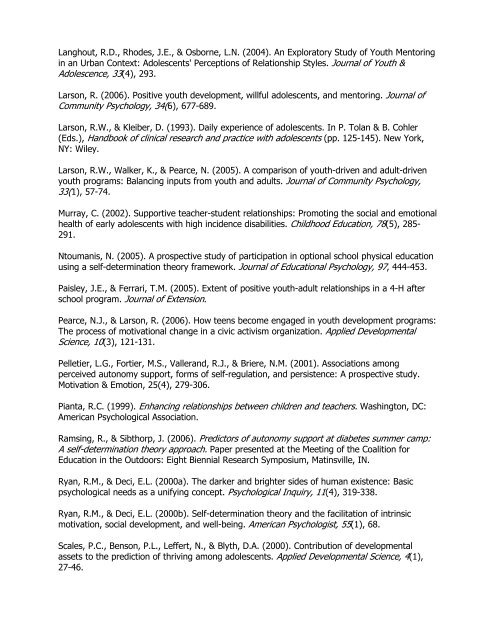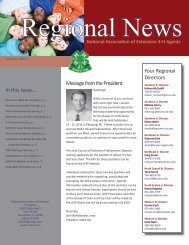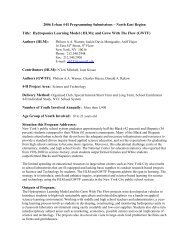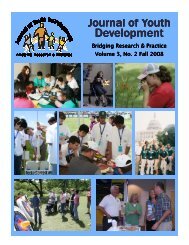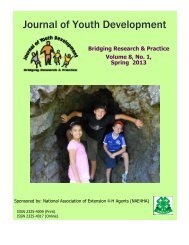Ellis, J.M., & Caldwell, L.L. (2005). Increasing youth voice. In P. A. Witt & L. L. Caldwell (Eds.),Recreation and Youth Development (pp. 281-299). State College, PA: Venture Publishing.Gest, S.D., Welsh, J.A., & Domitrovich, C.E. (2005). Behavioral predictors <strong>of</strong> changes in socialrelatedness and liking school in elementary school. Journal <strong>of</strong> School Psychology, 43(4), 281-301.Grolnick, W.S., Farkas, M.S., Sohmer, R., Michaels, S., & Valsiner, J. (2007). Facilitatingmotivation in young adolescents: Effects <strong>of</strong> an after-school program. Journal <strong>of</strong> AppliedDevelopmental Psychology, 28, 332-344.Grossman, J.B., & Bulle, M.J. (2006). Review <strong>of</strong> what youth programs do to increaseconnectedness <strong>of</strong> youth with adults. Journal <strong>of</strong> Adolescent Health, 39, 788-799.Grossman, J.B., & Rhodes, J.E. (2002). The test <strong>of</strong> time: Predictors and effects <strong>of</strong> duration inyouth mentoring relationships. American Journal <strong>of</strong> Community Psychology, 30(2), 199-219.Grossman, J.B., & Tierney, J.P. (1998). Does Mentoring Work?: An impact study <strong>of</strong> the BigBrothers Big Sisters program. Evaluation Review, 22(3), 403.Guzick, D.T., Dorman, W.J., Gr<strong>of</strong>f, T.S., Altermatt, E.R., & Forsyth, G.A. (2004). Fostering socialinterest in schools for long-term and short-term outcomes. Journal <strong>of</strong> Individual Psychology,60(4), 361-378.Herrera, C., Sipe, C.L., McClanahan, W.S., & Arbreton, A.J.A. (2000). Relationship developmentin community-based and school-based programs. Philadelphia, PA: Public/Private Ventures.Hill, E., & Sibthorp, J. (2006). Autonomy support at diabetes camp: a self determination theoryapproach to therapeutic recreation. Therapeutic Recreation Journal, 40(2), 107-125.Hughes, J.N., Cavell, T.A., & Willson, V. (2001). Further support for the developmentalsignificance <strong>of</strong> the quality <strong>of</strong> the teacher-student relationship. Journal <strong>of</strong> School Psychology,39(4), 289-301.Jekielek, M.A., Moore, K.A., Hair, E.C., & Scarupa, H.J. (2002). Mentoring: A promising strategyfor youth development. Washington, D.C.: Child Trends.Jones, K.R., & Perkins, D.F. (2006). Youth and adult perceptions <strong>of</strong> their relationships withincommunity-based youth programs. Youth & Society, 38(1), 90.Karcher, M.J. (2005). The effects <strong>of</strong> developmental mentoring and high school mentors'attendance on their younger mentees' self-esteem, social skills, and connectedness. Psychologyin the Schools, 42(1), 65.Karcher, M.J., Nakkula, M.J., & Harris, J. (2005). Developmental mentoring matchcharacteristics: Correspondence between mentors’ and mentees’ assessments <strong>of</strong> relationshipquality. The Journal <strong>of</strong> Primary Prevention, 26(2), 93-110.
Langhout, R.D., Rhodes, J.E., & Osborne, L.N. (2004). An Exploratory Study <strong>of</strong> Youth Mentoringin an Urban Context: Adolescents' Perceptions <strong>of</strong> Relationship Styles. Journal <strong>of</strong> Youth &Adolescence, 33(4), 293.Larson, R. (2006). Positive youth development, willful adolescents, and mentoring. Journal <strong>of</strong>Community Psychology, 34(6), 677-689.Larson, R.W., & Kleiber, D. (1993). Daily experience <strong>of</strong> adolescents. In P. Tolan & B. Cohler(Eds.), Handbook <strong>of</strong> clinical research and practice with adolescents (pp. 125-145). New York,NY: Wiley.Larson, R.W., Walker, K., & Pearce, N. (2005). A comparison <strong>of</strong> youth-driven and adult-drivenyouth programs: Balancing inputs from youth and adults. Journal <strong>of</strong> Community Psychology,33(1), 57-74.Murray, C. (2002). Supportive teacher-student relationships: Promoting the social and emotionalhealth <strong>of</strong> early adolescents with high incidence disabilities. Childhood Education, 78(5), 285-291.Ntoumanis, N. (2005). A prospective study <strong>of</strong> participation in optional school physical educationusing a self-determination theory framework. Journal <strong>of</strong> Educational Psychology, 97, 444-453.Paisley, J.E., & Ferrari, T.M. (2005). Extent <strong>of</strong> positive youth-adult relationships in a 4-H afterschool program. Journal <strong>of</strong> <strong>Extension</strong>.Pearce, N.J., & Larson, R. (2006). How teens become engaged in youth development programs:The process <strong>of</strong> motivational change in a civic activism organization. Applied DevelopmentalScience, 10(3), 121-131.Pelletier, L.G., Fortier, M.S., Vallerand, R.J., & Briere, N.M. (2001). <strong>Association</strong>s amongperceived autonomy support, forms <strong>of</strong> self-regulation, and persistence: A prospective study.Motivation & Emotion, 25(4), 279-306.Pianta, R.C. (1999). Enhancing relationships between children and teachers. Washington, DC:American Psychological <strong>Association</strong>.Ramsing, R., & Sibthorp, J. (2006). Predictors <strong>of</strong> autonomy support at diabetes summer camp:A self-determination theory approach. Paper presented at the Meeting <strong>of</strong> the Coalition forEducation in the Outdoors: Eight Biennial Research Symposium, Matinsville, IN.Ryan, R.M., & Deci, E.L. (2000a). The darker and brighter sides <strong>of</strong> human existence: Basicpsychological needs as a unifying concept. Psychological Inquiry, 11(4), 319-338.Ryan, R.M., & Deci, E.L. (2000b). Self-determination theory and the facilitation <strong>of</strong> intrinsicmotivation, social development, and well-being. American Psychologist, 55(1), 68.Scales, P.C., Benson, P.L., Leffert, N., & Blyth, D.A. (2000). Contribution <strong>of</strong> developmentalassets to the prediction <strong>of</strong> thriving among adolescents. Applied Developmental Science, 4(1),27-46.
- Page 2 and 3:
Winter 2008Volume 3 Number 3Editor
- Page 5:
Examining the Potential Unintended
- Page 8 and 9:
centered, multidisciplinary approac
- Page 10 and 11:
Volume 3, Number 3, Winter 2008Arti
- Page 12 and 13: fostering skill learning and positi
- Page 14 and 15: Table 1Participation in out-of-scho
- Page 16 and 17: ResultsOur analyses were conducted
- Page 18 and 19: watching TV, playing video games or
- Page 20 and 21: Accordingly, this research augments
- Page 22 and 23: Dotterer, A.M., McHale, S.M., & Cro
- Page 24 and 25: A Descriptive View of the 4-H Club
- Page 26 and 27: In this paper, the results of a cro
- Page 28 and 29: section is a set of statements that
- Page 30 and 31: Table 3Experience in the 4-H clubNo
- Page 32 and 33: significantly higher than Caucasian
- Page 34 and 35: p
- Page 36 and 37: This study focused only on the 4-H
- Page 38 and 39: Theokas, C., Lerner, J.V., Phelps,
- Page 40 and 41: Volume 3, Number 3, Winter 2008Arti
- Page 42 and 43: potential for reaching audiences, d
- Page 44 and 45: Putting Marketing Concepts into Pra
- Page 46 and 47: 2. Find out what others think about
- Page 48 and 49: Diem, K.G. (1994). What do youth li
- Page 50 and 51: Promoting Supportive Relationships
- Page 52 and 53: focused on youth-adult relationship
- Page 54 and 55: Conversely, more modern educational
- Page 56 and 57: perhaps most importantly, the effic
- Page 58 and 59: Organized youth programs, when stru
- Page 60 and 61: likely to internalize the positive
- Page 64 and 65: Schweinle, A., Meyer, D.K., & Turne
- Page 66 and 67: Volume 3, Number 3, Winter 2008Arti
- Page 68 and 69: This study uses the “5 Cs” mode
- Page 70 and 71: ResultsIn this analysis 48 codes we
- Page 72 and 73: Table 3Inductive Codes Classified b
- Page 74 and 75: CompetenceCompetence in organized s
- Page 76 and 77: ecause of him (the coach)…. You d
- Page 78 and 79: practices and competitions, the gir
- Page 80 and 81: Eccles, J.S., & Gootmann, J.A. (Eds
- Page 82 and 83: Smoll, F.L., & Smith, R.E. (2002).
- Page 84 and 85: Volume 3, Number 3, Winter 2008Arti
- Page 86 and 87: The present work builds upon that o
- Page 88 and 89: MethodSample and Data CollectionAs
- Page 90 and 91: (scores ranging from 0 to 8) and a
- Page 92 and 93: Table 2Paired Sample T-tests Compar
- Page 94 and 95: Hypotheses 5 and 6 were tested by c
- Page 96 and 97: De Coverly Veale, D.M.W. (1987). Ex
- Page 98 and 99: Story, M., Neumark-Sztainer, D., Sh
- Page 100 and 101: Volume 3, Number 3, Winter 2008Arti
- Page 102 and 103: Cronbach’s Alpha Score For Youth
- Page 104 and 105: 12 to 18 years old. Fourteen of the
- Page 106 and 107: Therefore, there was a mixed relati
- Page 108 and 109: Youth respondents identified two ob
- Page 110 and 111: are developed through working in a
- Page 112 and 113:
Seevers, B.S., & Dormody, T.J. (199
- Page 114 and 115:
Volume 3, Number 3, Winter 2008Arti
- Page 116 and 117:
With the many opportunities that yo
- Page 118 and 119:
meaningfully reduced involving dedu
- Page 120 and 121:
StaffingXTime/Schedule X X XTrainin
- Page 122 and 123:
“Involving adults that will allow
- Page 124 and 125:
“They can't drive or do not have
- Page 126 and 127:
page in understanding why youth voi
- Page 128 and 129:
Parker, L. (1999). If all youth ser
- Page 130 and 131:
Volume 3, Number 3, Winter 2008Arti
- Page 132 and 133:
However, the literature is mixed in
- Page 134 and 135:
group was the quality of the progra
- Page 136 and 137:
Table 1Reasons for Non-Attendance:
- Page 138 and 139:
easons given was six. Sixty-three p
- Page 140 and 141:
The non-family-related activities t
- Page 142 and 143:
“Catch ‘Em Being Good:”An Ext
- Page 144 and 145:
In 2001, the WVUES received a schoo
- Page 146 and 147:
to leverage the resources of the co
- Page 148 and 149:
4. Most primary behavior incidents
- Page 150 and 151:
Recommendations for developing prog
- Page 152 and 153:
Cross-Cultural UnderstandingThrough
- Page 154 and 155:
that plague these nations such as p
- Page 156 and 157:
2003). Youth leadership training in
- Page 158 and 159:
• enable these young people to pa
- Page 160 and 161:
We believe that the USPORT program
- Page 162 and 163:
West Virginia’s Response to theRo
- Page 164 and 165:
Ensuring good oral health requires
- Page 166 and 167:
Table 1Correlations between Planner
- Page 168 and 169:
problems in this rural state…This
- Page 170 and 171:
Volume 3, Number 3, Winter 2008Arti
- Page 172 and 173:
vacuum. Determination of factors, a
- Page 174 and 175:
ReferencesBaldwin, C., & Caldwell,
- Page 176 and 177:
Volume 3, Number 3, Winter 2008Arti
- Page 178 and 179:
Purpose of StudyThe purpose of this
- Page 180 and 181:
Students in the High computer gamin
- Page 182 and 183:
Do Higher Levels of 4-H LeadershipA
- Page 184 and 185:
IntroductionEmotional Intelligence
- Page 186 and 187:
second section examined demographic
- Page 188 and 189:
a constructive manner. The group is
- Page 190 and 191:
differences in the scores for the 1
- Page 192 and 193:
Adaptability include “Reality Tes
- Page 194 and 195:
ReferencesAmerican Academy of Pedia
- Page 196 and 197:
Healthy Kids, Healthy Families:A Co
- Page 198 and 199:
and a half million U.S. youth (ages
- Page 200 and 201:
Families. In partnering counties, p
- Page 202 and 203:
Healthy Families was then offered a
- Page 204 and 205:
Kamberelis, G., & Dimitriadis, G. (
- Page 206 and 207:
Volume 3, Number 3, Winter 2008Arti
- Page 208 and 209:
Change It Up!What Girls Say About R
- Page 210:
In addition, the study summarizes t


